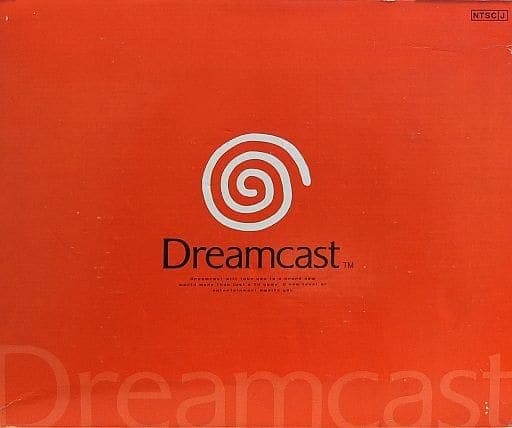Dreamcast主機
Dreamcast是SEGA於1998年推出的家用遊戲主機,被視為SEGA在家用遊戲機市場的最後一搏,也標誌著該公司的家用主機業務的終結。儘管具備強大的硬體性能並且擁有部分經典的遊戲作品,但由於種種原因,最終未能取得成功,並在短短幾年內退出市場。
於1998年11月27日在日本首次發售,隨後於1999年在北美和歐洲推出。採用Hitachi製造的SH-4處理器,主頻為200 MHz,處理器擁有相當強大的浮點運算能力,能夠處理複雜的3D圖形運算。圖形處理器則由NEC提供,名為PowerVR2,能夠支援640x480的解析度,並且能夠處理高達500萬多邊形每秒的圖形運算,在當時的主機市場中屬於頂尖水平。配備16MB的主記憶體、8MB的視訊記憶體以及2MB的音效記憶體。這些配置使得Dreamcast能夠流暢運行高品質的3D遊戲。還擁有一個GD-ROM光碟驅動器,這種光碟格式是SEGA專門為Dreamcast開發的,容量為1.2GB,相較於當時普遍使用的CD-ROM容量更大。還配備56K模組(北美版)或外接寬頻適配器,成為第一款支援網絡遊戲的家用主機。
主機的優點相當明顯。首先,其硬體性能在當時是非常先進的,特別是它的3D圖形處理能力,能夠展示出色的畫面和流暢的遊戲體驗。還配備創新的VMU(Visual Memory Unit)記憶卡,這是帶有小型顯示屏的存儲設備,可以將其插入控制器中,在遊戲中顯示額外的資訊,甚至可以用來進行一些簡單的遊戲,在當時是相當新穎的設計。此外,這是第一款具備網絡連接功能的家用主機,SEGA為此推出SEGA Net網絡服務,可以通過網絡進行遊戲對戰和下載內容。這一功能在日後的遊戲機上得到廣泛的應用,成為現代主機的標配。
然而,主機也存在著明顯的缺點。首先,GD-ROM 雖然容量大於CD-ROM,但仍不足以與當時逐漸普及的DVD相比。與Sony PlayStation 2採用DVD作為媒介不同,Dreamcast在存儲介質上的選擇限制遊戲開發者的創作空間,並且無法播放 DVD影片,這對於希望將遊戲機作為多功能娛樂設備的消費者來說是不小的劣勢。其次,網絡功能雖然先進,但當時的網絡基礎設施尚未成熟,網絡遊戲體驗有限,並未得到大多數玩家的廣泛應用。
儘管主機的壽命相對短暫,但仍誕生一些經典的作品。這其中包括《莎木》(Shenmue),被譽為是“互動電影”的遊戲,結合開放世界和故事驅動的玩法,對日後的遊戲開發產生深遠的影響。此外,《音速小子大冒險》(Sonic Adventure)是SEGA經典角色音速小子的3D化之作,以其快速流暢的遊戲體驗和色彩繽紛的畫面贏得眾多玩家的喜愛。其他如《夢幻之星 Online》(Phantasy Star Online),作為第一款成功的線上RPG遊戲,開創線上多人角色扮演遊戲的新紀元。《靈魂能力/劍魂》(Soulcalibur)是格鬥遊戲,以其出色的圖形和精確的操作手感成為Dreamcast的代表作之一。
SEGA Dreamcast在剛上市時曾一度取得不錯的銷售成績,最終全球銷量達到約930萬台。然而,這樣的數據遠未能達到SEGA的預期。最終在2001年3月31日停產,SEGA也正式宣佈退出家用主機市場,轉型為遊戲開發商。失敗主要歸因於幾個因素。首先,SEGA過去推出的Saturn主機失敗後,損害其在市場上的信譽,許多消費者及開發商對於新主機持保留態度,導致銷售開局不利。其次,Sony PlayStation 2的強大競爭使得Dreamcast在市場上難以立足。PlayStation 2不僅具備強大的硬體性能,還兼容DVD播放功能,這使得它在娛樂功能上具有更大的吸引力。
此外,SEGA的市場策略也存在問題,過早推出Dreamcast並未給予足夠的開發和宣傳時間。加之當時公司內部的財務困境和持續虧損,最終無力繼續支持市場推廣,導致在面對競爭對手時無法保持足夠的競爭力。總之,這是在技術上具有創新性和前瞻性的遊戲主機,儘管未能在商業上取得成功,但為產業帶來重要的創新理念,如網絡遊戲、VMU記憶卡等,這些創新在後續的遊戲主機中得到延續。Dreamcast的失敗也標誌著一個時代的結束,使得 SEGA在家用主機市場上從此退隱,但它的遺產和影響仍然被許多遊戲歷史學家和玩家所銘記。
The Dreamcast was a home gaming console released by SEGA in 1998, marking SEGA's last attempt to compete in the home console market and ultimately signaling the end of the company's involvement in this sector. Despite its powerful hardware and some classic game titles, the Dreamcast failed to achieve commercial success and was pulled from the market after only a few years.
The Dreamcast was first released in Japan on November 27, 1998, followed by its launch in North America and Europe in 1999. It was powered by a Hitachi-manufactured SH-4 processor with a clock speed of 200 MHz, featuring impressive floating-point performance capable of handling complex 3D graphics computations. The graphics processor, provided by NEC and named PowerVR2, supported a resolution of 640x480 and could handle up to 5 million polygons per second, making it one of the most advanced systems on the market at the time.
The console was equipped with 16MB of main memory, 8MB of video memory, and 2MB of sound memory, allowing it to run high-quality 3D games smoothly. The Dreamcast also featured a GD-ROM drive, a proprietary format developed by SEGA with a capacity of 1.2GB—larger than the standard CD-ROMs of that era. The console also came with a 56K modem (in the North American version) or an external broadband adapter, making it the first home console to support online gaming.
The strengths of the Dreamcast were apparent. Its hardware was highly advanced, especially in terms of 3D graphics processing, which enabled it to deliver impressive visuals and a smooth gaming experience. The console also introduced the innovative Visual Memory Unit (VMU), a memory card with a small display that could be inserted into the controller to show additional information during gameplay, and could even be used for simple mini-games—a novel design at the time.
Additionally, the Dreamcast was the first console to include online connectivity, with SEGA launching the SEGA Net service that allowed for online gaming and downloadable content. This feature set the stage for the widespread adoption of online capabilities in future consoles.
However, the Dreamcast also had significant drawbacks. The GD-ROM format, while offering more storage than a CD-ROM, fell short of the capacity offered by DVDs, which were becoming the standard at the time. Unlike Sony's PlayStation 2, which used DVDs and could also play DVD movies, the Dreamcast's choice of storage medium limited game developers' creative freedom and lacked the appeal of multifunctionality that consumers were beginning to desire. Furthermore, while the console's online features were ahead of their time, the limited network infrastructure of the era meant that online gaming experiences were inconsistent and not widely adopted by the broader gaming community.
Despite its short lifespan, the Dreamcast produced several classic games. Shenmue, often hailed as an "interactive movie," combined open-world exploration with a story-driven experience and left a lasting impact on future game development. Sonic Adventure, featuring SEGA's iconic character Sonic the Hedgehog in 3D, was loved for its fast-paced gameplay and vibrant visuals.
Other notable titles include Phantasy Star Online, the first successful online RPG, which pioneered the genre of online multiplayer role-playing games, and Soulcalibur, a fighting game renowned for its outstanding graphics and precise controls, becoming one of the Dreamcast's flagship titles.
Initially, the Dreamcast achieved promising sales, with global sales reaching around 9.3 million units. However, this fell short of SEGA's expectations, leading to the console's discontinuation on March 31, 2001, and SEGA's subsequent withdrawal from the home console market to focus solely on game development.
The Dreamcast's failure can be attributed to several factors. Firstly, SEGA's previous console, the Saturn, had failed, damaging the company's market credibility, leading many consumers and developers to approach the new console with caution, which hurt its initial sales. Secondly, the competition from Sony's PlayStation 2 was overwhelming. The PlayStation 2 not only boasted superior hardware but also featured DVD playback, making it more appealing as a multifunctional entertainment device.
Moreover, SEGA's marketing strategy was flawed; the premature launch of the Dreamcast did not allow enough time for development and promotion. Coupled with SEGA's financial struggles and ongoing losses, the company was unable to maintain competitive momentum in the face of rising competition.
In summary, the Dreamcast was a technically innovative and forward-thinking console. While it failed commercially, it introduced important concepts such as online gaming and the VMU memory card, which influenced future consoles. The Dreamcast's failure marked the end of an era, leading SEGA to exit the home console market, but its legacy and impact are still remembered by many gaming historians and fans.
運費計算方式:
貨款滿1000元運費外加90元
貨款1000以下:買1件運費外加 60元,買2件運費外加 70元,
買3件運費外加 80元 ,買4件運費外加 90元
貨到付款外加30元手續費
外島及大陸地區運費另計
付款方式:
線上刷卡:本站採用Paypal線上刷卡
虛擬帳號匯款:屬於您專屬的虛擬帳戶,方便站長查帳使用,本站強力推薦
實體ATM匯款:請將匯款帳號記錄下來至各大銀行ATM提款機轉帳
超商條碼繳費:請列印本站提供的條碼至四大超商繳費
線上轉帳:透過玉山銀行線上ATM轉帳(此系統只支援IE瀏覽器)
貨到付款:本站採用黑貓宅急便貨到付款
其他注意事項:
如需購買線上點數卡請直接跟站長連絡,本站不提供點數卡的線上付款
-
Dreamcast主機
- 定 價: 32,780円
- 售 價: 0.00
- 庫存量: 0 套
- 已賣出: 0 套
 人氣指數: 0.7 / 6 顆星
人氣指數: 0.7 / 6 顆星

